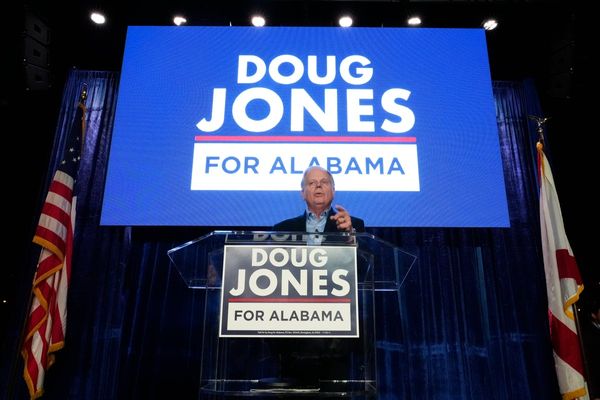
TV advertising continues to rack up large bills for political parties during federal election campaigns but third-party interest groups are increasingly using social media to deliver targeted messages to voters.
With multiple seats determined by very fine margins, targeted messaging can sway just enough to influence a third-party group’s preferred outcome.
At least, that’s what some campaigners tell their financial backers.
A Guardian Australia analysis of social media advertising of 15 interest groups across the political spectrum showed more than $7m was spent on ads on YouTube, Meta and Google search over the five-week campaign.
Of that figure, at least $1.6m was spent on 30 of the most hotly-contested seats.
The marketing professor Andrew Hughes said third-party ads could subtly influence voters but success varies wildly.
Voter attitudes towards both the brand and the ad’s content matter, Hughes said.
“Third-party advertising is really handy for a major party because they add credibility and authenticity to a message,” he said. “But if you don’t like the brand, it doesn’t work.”
Rise of the third-party campaigners
While unions have long been a part of the election campaign advertising fabric, they no longer occupy the space alone.
The rightwing activist group Advance has emerged in recent years as a powerful fundraising force, banking $15.6m in donations during the 2023-24 financial year.
Analysis of data collected by the Populares ad tracker showed Advance spent $1.7m in social media advertising across its various Facebook pages and $239,300 of that was targeted at its key seats.
Its efforts focused most intensely on seats where the Greens had a chance at winning, including Brisbane, Macnamara, Griffith, Ryan and Wills.
“We have destroyed the Greens,” an Advance spokesperson told Guardian Australia.
“In every seat we targeted, the Greens have suffered terminal declines in their primary votes.”
The Greens’ primary vote in Brisbane, Macnamara, Griffith and Ryan did fall slightly in the 2025 poll. However, it increased by 2% in Wills.
Despite Advance’s claims to have played a role in unseating the Greens leader, Adam Bandt, the data showed no social media advertising was targeted specifically at his Melbourne seat.
A number of other right-leaning groups joined the fray in recent months, including Better Australia and J-United, which both targeted Greens and teal independents.
Ad tracking data showed Better Australia spent $373,209 on social media advertising during the campaign. Almost $33,000 was spent on geo-targeted ads focused on Goldstein, Bradfield, Curtin, Brisbane, Ryan and Wills.
Another new entrant was the anti-Greens and anti-teals group Australians for Prosperity, which spent $414,903 on online ads.
The group’s spokesperson, Jason Falinski, said its campaign focus was economic issues and to target inner-city seats previously dominated by the Liberals.
Falinski, a former Liberal MP who was unseated by the teal independent Sophie Scamps, said he didn’t want to “waste” money on Anthony Albanese’s seat in Sydney’s inner west.
Its targeted ads hit the Greens seat of Brisbane as well as Bradfield and Bennelong in Sydney, and Bruce, McEwen and Aston in Victoria.
The Australian Taxpayers’ Alliance spent $597,758 on ads, targeting marginal Labor seats in Aston, Dobell, Dunkley, Gilmore and Roberston along with Deakin, where shadow minister Michael Sukkar lost his seat to Labor.
Left-leaning groups also racked up big social media advertising bills.
The Australian Unions and United Workers Union together spent $1.85m with $826,597 going toward geo-targeted social media ads on YouTube and Meta.
The Australian Unions spent more than $50,000 per seat on geo-targeted ads in some electorates, including Bruce, Dunkley, McEwen, Chisholm, Hawke, Blair, Bennelong and Tangney.
A little-known climate change interest group, Hothouse Magazine, spent close to a $500,000 on social media advertising.
Focusing on seats such as Goldstein, Curtin, Bradfield, Dickson and Cowper, where it spent around $36,000 on targeted ads, a spokesperson said “the election was the perfect opportunity to fire up the engine and have a crack at making an impact”.
The new entrant gained notoriety for linking Peter Dutton to Donald Trump, including corflutes depicting the opposition leader with Trump’s signature blonde combover.
Other pro-climate groups, such as Solutions for Climate Australia, It’s Not a Race and Clean Energy Council, spent more than $200,000 on social media ads.
Still, the numbers fall well short of the major parties, who collectively spent more than $29m across the sites.
Labor took the lead with $17.6m in spending, with the Liberals trailing on $10.8m and the Nationals on $650,000.
Are financial backers getting bang for their buck?
While the data shows third-party interest groups aren’t afraid to spend millions online to influence voters, does it actually shift the dial?
The campaigners say yes.
Advance’s spokesperson described its campaign as a success after the Greens’ lower house losses.
“We ran the biggest third-party campaign ever seen at an Australian election against the Greens,” they said.
“For more than a year, we delivered millions of ads across TV, YouTube, Facebook, and Instagram as well as millions of flyers distributed in target electorates. We ran ads on billboards, bus shelters, mobile trucks and delivered an on-the-ground field campaign during the election.”
Similarly, Hothouse said its messaging was “impressively influential” in taking aim at their right-leaning counterparts.
“Sure, money can buy people’s attention, and if you slap them in the face enough with a message it’ll stick,” a spokesperson said.
“But our content actually had some personality with a priority to inform rather than manipulate – a novel concept in this space that helped us punch above our weight.”
Falinski also said Australians for Prosperity would take credit if Gisele Kapterian is successful in overcoming her teal challenger, Nicolette Boele, in Bradfield.
“The one thing I have learned is never, never be shy about claiming something,” Falinski joked.
But claiming a win directly off the back of online campaigns is dubious, Hughes said.
“I think it’s very dubious to claim that you’ve got that correlation effect happening. You say ‘they didn’t get elected, therefore the advertising worked’. Well, maybe yes and maybe no, because unless you do the real causation studies, which are things like recall, it’s very, very hard to discern,” he said.
With thousands of online ads fighting for eyeballs, Hughes said voter fatigue would have limited the success of most ads unless they could capture a voter’s attention for at least two seconds.
The quality and simplicity of the content was key, he said, but the brand associated with it mattered too. For example, Hughes said, Advance has more visibility as an anti-Labor and anti-Greens group and therefore its messages were unlikely to resonate with progressive or left-leaning voters.
Given Hothouse’s relatively low-level brand recognition, Hughes said its ads linking Dutton to Trump would likely have planted the seed in some audiences. And it did that with less than a third of Advance’s budget.
“That’s the power of social media, really. In a nutshell, it’s a subtle effect, it’s a lag effect. And it’s an effect based on your [perception] of the content,” Hughes said.
While the money third-party campaign groups spent on social media advertising paled in comparison to major parties, Hughes said their impact in future elections shouldn’t be written off just yet.
“When you feel part of a group, you’re more likely to conform to the group’s behaviours and vote for the way the group is leaning towards, and that’s where the impact is,” he said.







